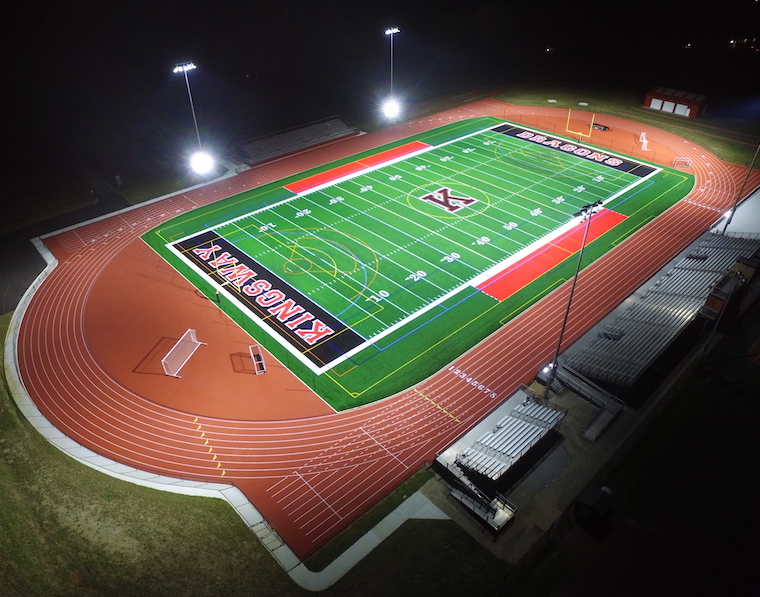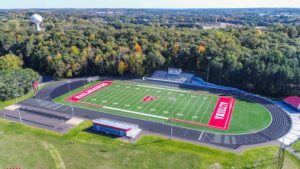By Mary Helen Sprecher
Track and field facilities are three-season facilities. In some areas, they might be busy all year long, which is part of the problem when it comes to maintenance. How do you make time for necessary work without disrupting games and practices?
Sports construction professionals recommend first developing a calendar of how many sports are using the field – and when.
According to Paul Arcella of Heavy & Athletic in Deerfield Beach, Fla., the scope of use a facility bears can be surprising.
“The number of competitive sports, the location of the track, and the schedule all need to be taken into consideration. Where we are, in Florida, if you’re thinking about what goes on at the high school level, football usually is king. Most schools have varsity and JV teams, and some of the more competitive schools also have freshman teams. The end of football season overlaps soccer. For most schools, there are varsity and JV teams for boys and girls soccer. That season rolls into lacrosse, which also has boys’ and girls’ teams at the varsity and JV levels. That season then rolls into track and field, which, again, has boys’ and girls’ teams and lasts until late April or early May. That gives way to spring football to close out the year.”
Roll in band practices, summer camps, tournaments that are held in the offseason, as well as normal PE classes that might use the track and field throughout the year, and, according to Arcella, “the track and field really never get a break.”
It’s easy for athletic directors and coaches to lose sight of maintenance. And if a facility is fairly new, or in good shape, the inclination might be to ignore it.
“It’s important to develop a maintenance program that fits how they use their field and track,” added Arcella.
While tracks and fields are, of course, different facilities, thinking of them as two parts of one integrated facility that needs regular maintenance is key to keeping them in top form.
Basic maintenance for both parts of the facility includes a hefty dose of preventive medicine. In both cases, it is essential to keep the surface clean.
For track surfaces, this means addressing any unwanted debris, including sand, dirt, grit, leaves, etc. By using a leaf blower to keep the track free of material like this, you avoid these things being ground into the track and, over time, damaging the surface. If more intensive cleaning is needed, consult your track builder, who has access to specialized equipment that can deep-clean the surface without damaging it.
Keep an eye on curbs, drains and other areas as well.
“A sports facility manager should also focus on clearing drain inlets regularly,” said Todd Wiggin of Sports Turf Company in Whitesburg, Ga. “Drain inlets should be free of grass clippings, trash or any foreign objects that could obstruct runoff. This helps prevent drainage backups and prevents any water-related damage to both your track and field.”
Test the field irrigation system, and make sure sprinkler heads are distributing water evenly, and on the field only. Look for wet spots on the track or on nearby structures that would indicate misdirected water. Also check for any areas where the field seems to hold water longer than others; this may be indicative of a drainage problem. And, of course, if you notice water puddling on the track, it could be indicative of a low spot that a contractor should address.
Even if they don’t have to be mowed and fertilized, synthetic fields need regular care, as well.
“Synthetic turf and running tracks are ‘low maintenance,’ not ‘no maintenance,’” said Arcella.
Arcella recommends weekly sweeping and cleaning of trash, leaves and other debris; if weekly isn’t enough to stay on top of the problem, increase it to two to three times a week.
A lack of grooming leads to matting down of the fibers in areas of heavy use on the field. If caught early, the problem can be corrected. Without regular maintenance, however, it can lead to bigger problems with the surface that can, over time, shorten the field’s useful life.
Synthetic fields are a significant investment for the schools and parks that own them, benefit from an owner who keeps open the lines of communication with the builder who installed them. By doing regular walk-throughs of the facility and sending photos regarding any areas of concern, it is possible to head a lot of problems off at the outset.
“Backpack blowers can be utilized for leaves and the like, but the operator needs to be careful not to displace the infill by directly blowing downward into the turf,” said Arcella. “We also use a drag mat ‘friction’ sweeper pulled by a small golf cart or utility vehicle.”
There are several vehicles on the market that can be used strictly in maintenance work on synthetic fields, including those that vacuum fields, remove any metal and re-level the infill. A specialty contractor with expertise in sports fields can provide advice on such equipment. Note that such vehicles should have special turf tires that keep them from damaging the field.
When using vehicles in any maintenance work, it is essential to protect the track from the damage that can result. It is easy to think that if a vehicle is only driven across the track occasionally (or quickly, or slowly), that it will not cause harm to the athletic surface. Unfortunately, this is not the case.
Track contractors recommend putting sturdy boards over the track and covering them with a tarp or rubber matting in order to allow vehicles to cross safely.
Arcella added that field owners should always be aware of the need to protect the track.
“Create crossovers for athletes who will be using the main inner field and who will most likely be wearing cleats. These crossovers could be a heavy tarp, rigid mats or weighted tarps,” he said. “There are several sports vendors that supply these types of track protection and they’ll help keep the surface free of nicks, indentations and the like.”
Keep tabs on the track surface by walking around it regularly. If patching is needed or if damage is present, report it to your track builder, who will know what to do. Unfortunately, it is not uncommon for problems to be noticed at the end of one season (for example, spring), but because the track is not going to be needed by the school over summer vacation, the problem might not be reported until the following fall, and, in the intervening time, it has gone from a minor issue to a major repair.
“Facility managers should ensure a proper maintenance routine is in place even during periods of limited use of the facility,” said Wiggin. “Regular maintenance should include collecting debris from the track and field, checking drain inlets and regular field maintenance. It is important to properly secure the facility if personnel are not there on a regular basis to prevent any unscheduled activity.”
Lighting should also be checked regularly to ensure all fixtures are working properly and that there are no problems. Check fencing and gates and make sure no rails are loose and no fabric is bulging. Look at bleachers and railings, as well as steps.
In many cases, track and field facilities are open for community use during the summer as well as during the school year when students are not using it. Because, at such times, the facility is largely unsupervised, it is important to try to safeguard against misuse that can result in damages.
“It is important to have rules posted about the use of your track and field facility so that summer visitors can easily see them,” said Wiggin. “The rules for your facility should clearly list the types of things that are allowed and are prohibited to avoid any damage to the facility. It is important to discourage the use of spiked shoes, chairs, skates, narrow wheeled strollers, tricycles and bicycles on your running track to prevent premature wearing. If there is an event with lots of traffic across the running track specifically, we recommend crossing mats to protect the track surface and prevent excess wear in a concentrated area.”
The listed rules should include a phone number that visitors can call with any concerns, including problem users or damage to the facility they may have observed.
Put locking covers onto sand pits, since parents who bring their toddlers tend to use them as sandboxes, leading to sand getting tossed out and various debris being left behind, which could harm athletes when the sand pits go into use again.
Make sure to do periodic check-ins to see whether the track and field are in good shape; if it looks as though they are suffering from the effects of too much unsupervised use, you may need to revisit the decision about it.
Mary Helen Sprecher wrote this article on behalf of the American Sports Builders Association (ASBA).
In-depth information on the maintenance of running tracks and sports fields can be obtained from the American Sports Builders Association, the non-profit association helping designers, builders, owners, operators and users understand quality sports facility construction. ASBA’s publications, including Running Tracks: A Construction and Maintenance Manual, and Sports Fields: A Construction and Maintenance Manual, are available for purchase from the Association. The ASBA may be reached via its website, www.sportsbuilders.org, or via e-mail at info@sportsbuilders.org.



